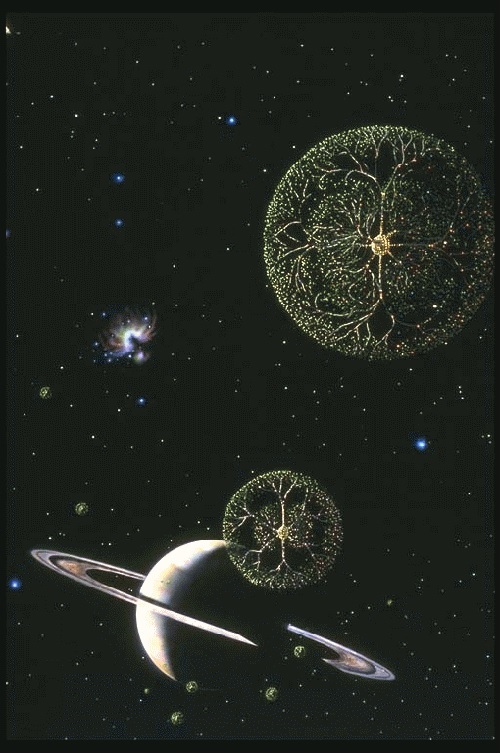Centauri Dreams
Imagining and Planning Interstellar Exploration
August 25, 2012: Interstellar at Last
Tracking Voyager 1 outbound for the past decade has been at times anti-climactic. Had the spacecraft reached interstellar space or hadn’t it, and how exactly would we know? The announcement last week that the milestone has been reached will forever mark August 25, 2012 as the date when a human-built object, still returning data, made the crossing. That it took a year of analysis only reminds us how much we have to learn about even this closest region of the space between the stars, where some interactions with the Sun continue.
“We have been cautious because we’re dealing with one of the most important milestones in the history of exploration,” said Voyager project scientist Ed Stone of the California Institute of Technology in Pasadena. “Only now do we have the data — and the analysis — we needed.”
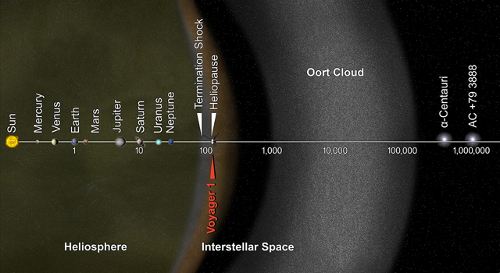
Image: I use this image — or one much like it — all the time in my talks because it puts huge Solar System distances in perspective. The scale bar is measured in astronomical units (AU), with each set distance beyond 1 AU representing 10 times the previous distance. Each AU is equal to the distance from the Sun to the Earth. It took from 1977 to 2013 for Voyager 1 to reach the edge of interstellar space. Credit: NASA/JPL-Caltech
The caution has certainly been justified. Voyager 1’s plasma spectrometer — able to measure the ionized gas, or plasma, that essentially inflates the heliosphere — stopped working all the way back in 1980. The direction of magnetic field lines emanating from the Sun became became the alternative marker, since solar plasma and interstellar plasma were expected to differ in direction. Another marker: The level of charged particles inside the heliosphere should drop and the level of galactic cosmic rays should rise when the heliosphere was truly crossed.
Last summer brought changes beginning in May and accelerating in July with a jump in the number of outside particles and a drop in the charged particles from the Sun. Confusingly, the magnetic field direction had not changed — was the spacecraft still inside the heliosphere? A solar storm early in 2012 may have furnished the answer. Leading the plasma wave science team, Don Gurnett and Bill Kurth (University of Iowa) realized that radio activity observed earlier in the mission had been the result of interstellar plasma encountering bursts of solar material.
The oscillations caused by such events should be observable when Voyager 1 is surrounded by interstellar plasma, and plasma oscillations in the spring of this year had the signature of that plasma, evidently the outflow from the March, 2012 solar flare activity. The scientists made the call based on the observed electron density of the plasma, which is higher in the interstellar medium. Working back through the data, the duo could pin the onset of these interactions to August of 2012, consistent with the earlier changes in charged particles and doubtless related to the burst of solar activity that set the plasma in motion. While amidst interstellar plasma, the spacecraft was still feeling some influence from the Sun. Let me quote Stone again on this:
“Now that we had actual measurements of the plasma environment – by way of an unexpected outburst from the sun – we had to reconsider why there was still solar influence on the magnetic field and plasma in interstellar space. The path to interstellar space has been a lot more complicated than we imagined.”
NASA is now saying that by August 25 the spacecraft had entered the interstellar region for good, an indication that the heliopause had been crossed. The Voyager team is in agreement that the spacecraft is in interstellar space, although Stone refers to it as “a mixed, transitional region,” and we still see some solar influence, possibly including the unchanged direction of the magnetic field, which is puzzling. Voyager 1 seems to be illustrating what we have been learning for the past sixty years, that the Solar System and its surroundings are much more varied and diffuse than we previously thought. We once conceived of our system as a place of nine planets and a belt of rocky debris. Now we know about numerous small worlds in the Kuiper Belt, a second band of rock and icy objects, and have re-tooled the very definition of the word ‘planet.’ We’ve also learned we’re surrounded by trillions of comets.
That latter point deserves some attention, for the numerous headlines talking about Voyager 1’s departure from the Solar System reflect a continuing misunderstanding about what the system actually is. The Oort Cloud is widely accepted as the home of long-period comets, occasionally jolted by gravitational interactions into sending a new comet into a Sun-grazing orbit. To leave the Solar System, we have to speak of going to a place where the Sun’s gravity no longer dominates, and that could take us out 100,000 AU or more. Voyager 1’s passage through the Oort Cloud will be measured in tens of thousands of years. In 40,000 years, Voyager 1 will be closer to the star AC +79 3888 than to our own Sun.
One of those headlines mistakenly saying that Voyager 1 had left the Solar System occurred in the Washington Post, but the article nonetheless contained this gem:
Launched in 1977, the Voyager’s computing power was impressive for its time. The spacecraft was designed to run most of its operations itself, since the billions of miles separating it and Earth make communication laggy. To accomplish that, Voyager has three interconnected computer systems: one to control the craft’s flight and altitude, another to control its instruments, and a third to manage the first two. The computers can process about 8,000 instructions per second — a fraction of the capability of your smartphone, which handles upwards of 14 billion each second. With memory measured in kilobytes, they can hold only hold a few thousand words worth of text.
We haven’t left the Solar System, but at 121 AU we’ve punched through the heliopause and are in a region where our spacecraft is surrounded by material from other stars rather than being dominated by plasma from the Sun. The achievement is colossal: We launched the Voyagers in 1977 on a mission designed to study specific planetary targets, with no expectations that they could be pushed to become our first interstellar probes. Their data are stored on 8-track digital tape recorders and broadcast back to Earth with a 23-watt signal. That Voyager 1 has now managed the journey speaks to the quality of its construction and the dedication of the teams that have monitored it over the decades. What more will it tell us before it falls finally silent?
The paper is Gurnett, Kurth et al., “In Situ Observations of Interstellar Plasma With Voyager 1,” published online in Science 12 September 2013 (abstract).
Addendum: This just in from Jim Benford, who has been calculating when Voyager 2 and New Horizons will cross into interstellar space:
New Horizons is going the same direction as Voyager 2, as projected onto the ecliptic, but Voyager 2 is going south of the plane, New Horizons staying approx in the plane. It’s headed toward Sagittarius.
- If the ISM is the same distance as Voyager 1 found it (122 AU), New Horizons will take 30 years to reach it. [New Horizons is going 3.165 AU/yr, is 27.35 AU out].
- Similarly, if the ISM is the same distance as Voyager 1 found it, Voyager 2 will reach the ISM in 4.9 years.

Riding on Comets’ Coat-tails
Voyager 1 is now an interstellar spacecraft, according to the latest reports (and I’ll have thoughts on Voyager, its progress and its implications, on Monday). For today, though, Keith Cooper is envisioning other ways of going interstellar, methods that take advantage of natural objects like comets. Can we harness their resources and change the paradigm of deep space flight? Keith has written often for Centauri Dreams despite a busy schedule as editor of the British monthly Astronomy Now and equivalent duties at Principium, the newsletter of the Institute for Interstellar Studies. This look at how we might expand into the Oort Cloud and beyond takes us into a future in which our species may well differentiate as we explore different ways of reaching the stars.
by Keith Cooper

Amidst the clamor for giant metal-hulled ships, fusion engines and warp drive, our interstellar pioneers may be missing a trick. Why go to all the trouble of building a starship when there are trillions of natural ones right on our doorstep?
After I reviewed W. Patrick McCray’s book The Visioneers in my last column I picked up some old copies of Omni magazine from eBay on the strength of the magazine’s portrayal in the book. Flicking through the June 1984 issue I stumbled upon an article about using comets ejected from our Solar System as vessels to transport us through interstellar space. This instantly took me back to a few months earlier and a conversation with space artist Jon Lomberg, who mentioned artwork he did for Carl Sagan of ‘treeships’ – living, hollow trees grown out of comets, riffing on an original premise by physicist Freeman Dyson.
Comet ships are an old idea that does not seem to have received much airtime recently, but with all eyes on Comet ISON this winter it is the perfect opportunity to revisit this novel notion. ISON itself is a five-kilometre wide chunk of ice, rock and dirt that is racing towards the Sun. It hit headlines last year with claims that it could, for a short time, outshine the full Moon, but expectations have been significantly downgraded since then. Nevertheless, there is still hope that it will grow as bright as Venus near perihelion on 28 November – assuming it isn’t vaporised in the heat of the Sun as it flies within 1.8 million kilometres of our star.
If it survives its solar encounter, the comet will be flung back into the Oort Cloud – the distant realm of the comets – and it may even be ejected from the Solar System entirely on a parabolic trajectory. That’s a remarkable thought: the comet would enter interstellar space, to wander lonely between the stars and to maybe, one day, be picked up by another star. The comet highway could work both ways – the short period comet 96P/Maccholz is suspected by some scientists to have originated from another star system, based on what appears to be a carbon depletion seen in the abundance of molecules like cyanogen compared to other comets in our Solar System (although it should be stated that there are also more mundane explanations for 96P’s weird chemistry). Computer simulations of the formation and evolution of the Oort Cloud indicate that up to a hundred times more comets are ejected into interstellar space than remain in the Sun’s grasp. The Solar System is literally shedding comets in their billions.

Image: Hubble’s view of Comet ISON (C/2012 S1) on April 10, 2013. This image was taken in visible light. The blue false color was added to bring out details in the comet structure. Credit:NASA, ESA, J.-Y. Li (Planetary Science Institute), and the Hubble Comet ISON Imaging Science Team.
Cometary Trajectories Outward
No astronomer has ever observed the Oort Cloud directly – it is too distant, its inhabitants too small and too faint – but we know the cloud must exist there as the orbits of long-period comets indicate they originate in all directions from a region that exists between as close as 2,000 and as far away as 50,000 astronomical units. Models suggest that the Oort Cloud comes in two parts – an inner doughnut shaped region and an outer spherical halo, together containing more than a trillion icy bodies. It is from the loosely bound outer cloud that the long-period comets like ISON hail – and which interstellar comets must also originate.
We could take advantage of these escaping comets, eschewing the need to scratch-build complete starships and loading millennia’s worth of supplies onto them when we can just hitch a ride on a comet. After all, comets come ready-made, endowed with resources and volatiles: plenty of water, metal ores, even large stocks of deuterium to help fire a fusion reactor. One downside is that we might not have too much say about where the comet is heading, but given that the Solar System will eject comets randomly in all directions, hopping aboard them may pave the way for the full blown diaspora of humanity into the Milky Way at large.
Catching a comet when it is near the Sun might not be the best option. As a comet receives greater solar energy it warms, developing the familiar fuzz of the coma and a trailing tail as ice on its surface sublimates into vapour. More violently, gases trapped within pockets inside the comet’s porous structure begin to expand, often bursting out explosively. The comet would be unstable, even out beyond the orbit of Mars, as 2008’s outburst from Comet 17P/Holmes proved. Instead the best time to latch onto a comet could be when it is receding back into the outer Solar System and things have settled back down on its surface.
There’s an added problem. Human activity on a comet could kick the activity off again, so actually building habitats on or inside comets is not going to work. Consequently, the best tactic might be to live in habitats that are tethered to and which siphon materials from a comet. It is not yet clear how we could mine a comet safely, but the comet’s deuterium, locked in its water-ice, will be essential to the interstellar travellers if they want to survive their journey.

Image: Comet Halley, as seen in 1986 by the European spacecraft Giotto. Data from Giotto’s camera were used to generate this enhanced image of the potato shaped nucleus that measures roughly 15 kilometers across. Some surface features on the dark nucleus are on the right, while gas and dust flowing into Halley’s coma are on the left. Credit & Copyright: Halley Multicolor Camera Team, Giotto Project, ESA.
Energy can be derived from nuclear fusion using deuterium. It is particularly abundant in comets – Comet Hale-Bopp, which graced our skies in 1997, was shown to contain an abundance of deuterium twice that of Earth’s oceans, at a ratio of 1:6,410 compared to regular hydrogen. This is three times as much as astrophysicist Eric Jones predicted when writing on the subject in 1985’s Interstellar Migration and the Human Experience, where he speculated that one deuterium atom for every 20,000 hydrogen atoms in a comet should be sufficient to power fusion to sustain a significant population of interstellar voyagers for many centuries. We see this scenario being played out in [be warned, spoilers] Greg Bear’s novel Hull Zero Three, where three cylinders are affixed on stanchions to a central comet from which resources are being drawn. Alas, interstellar travel times for comets are measured in millennia, not centuries, so an additional power source will also be required.
Deep into interstellar space the singular power of the Sun fades into insignificance. However, despite being at great distance the collective starlight of all the stars could, says Jones, produce several hundred megawatts of power. Huge parabolic mirrors built out of aluminium mined from a comet could be constructed to capture and focus diffuse starlight. Inspired by Robert Forward’s book The Flight of the Dragonfly, in which the main spacecraft used similar mirrors to capture and focus the laser light that is beamed towards it from the Solar System and which is driving it forward to Barnard’s Star, Jones suggests that, at around 1.6 light years from the Sun, the mirrors would require a diameter of 3,000 kilometres. Cluster a bunch of comets together, says Jones, and the inhabitants could tend to a farm of mirrors 30,000 kilometres across. Combined with fusion reactors, these mirrors should be able to supply power to the comet cluster’s inhabitants for as long as the community exists.
Biotechnology and the Interstellar Diaspora
Nevertheless, it all sounds like a terribly hard way to live, a subsistence existence. Small communities in tiny tin cans eking out their lives surviving off a trickle of energy derived from raw starlight and a few centuries worth of fusion power, light years from any planetary system. It is difficult to think of a reason why anybody would want to travel to the stars this way. Jones suggests that bands of nomads, clans and tribes residing in the Oort Cloud in the future would be most likely to embark on such a lonely journey, mirroring the voyage into the unknown Pacific made by the Polynesian explorers a thousand years ago. It is a thought that Freeman Dyson concurs with, a thought that he voiced at his talk at the recent Starship Century symposium in May this year. For Dyson, in a few centuries there could well be more people living in the Oort Cloud than are living on Earth. If this is to be the shape of the future diaspora it couldn’t be further from the organised, planned launch of gun-metal grey starships with hand-picked crews that we envisage today.
Before dismissing cometary travel as a venture only for a rabble of humans, Dyson perhaps has a better idea, one that raises itself above the mundane toil of living off a comet in the conventional way, to arrive at a level of magnificent eloquence and beauty.
During his Starship Century speech, Dyson revisited an old idea of his dating back to 1972. He postulated with a degree of confidence that biotechnology will come to dominate the future, inevitably instigating a number sociological changes in humanity, some that we might predict, others that we cannot. One possibility that Dyson does predict is the existence of ‘big trees’ – genetically modified plants designed to survive in space that would grow to enormous sizes, many kilometres across, with their roots ensconced within a nutrient-rich comet. The tree would be so huge that it would contain hollow, airtight spaces where people could live. Furthermore, the plants could grow their own greenhouses, “just as turtles grow shells and polar bears grow fur and polyps build coral reefs in tropical seas,” according to Dyson. They would produce their own oxygen supply from photosynthesis, like any other plant, while an array of lenses and mirrors could focus light from the distant Sun and stars into the greenhouse. It is an idea that has had a little play in science fiction, such as in Dan Simmons’ novels like Hyperion:
“The Consul remembered his first glimpse of the kilometre-long treeship as he closed for rendezvous… it’s leafy bulk clearly ablaze with thousands of lights which shone softly through leaves and thin-walled environment pods, or along countless platforms, bridges, command decks stairways and bowers. Around the base of the treeship, engineering and cargo spheres clustered like oversized galls while blue and violet drive streamers trailed behind like ten-kilometre roots.”
Image: This painting by Jon Lomberg was commissioned for the book Comet by Carl Sagan and Ann Druyan, to illustrate a concept proposed by physicist Freeman Dyson. Dyson suggested that in the future, comets could be used as the source of minerals and water to support the growth of gigantic, genetically engineered trees. These trees would use sunlight to grow to large size, and provide a habitat for space colonists. Credit: Jon Lomberg.
Biotechnology could play a significant role in adapting life for the harsh conditions on the rim of the Solar System. Rather than toiling away on comets, Oort Cloud denizens could use biotechnology to adapt to be more efficient with limited resources and create a balanced ecosphere in their habitats. While we are currently busy tinkering with our paper designs for starship drives and metal spaceships, are we blind to the oncoming biotechnological revolution and could it be this that leads us to the stars rather than fusion engines, antimatter or warp drive?
Perhaps, but there would be a downside. Sticking engines on a comet or a ‘treeship’ as in Simmons’ novel is probably impractical if we are limiting ourselves to the resources available only on the comet or via captured in starlight. Instead, riding on a comet will mean taking the slow road to the stars. We shouldn’t expect to get anywhere on them for tens or even hundreds of thousands of years. By necessity they would become generation ships, at their greatest a fleet of mobile O’Neill colonies, or a literal floating forest spurring the “greening of the Galaxy” where starships are grown, not built.
If we are to pursue the faster route, constructing engines of enormous power settled into vast metal hulks, then perhaps the the comet travellers play a different role. Maybe they will never reach the stars, but instead settle into the dark spaces between, way-stations for lost or weary travellers who have followed later in their faster metal starships. Two different populations moving out into the Galaxy and occasionally meeting, each pursuing distinctly different technologies, each growing and changing in their own different ways, one driven by the green efficiencies of biotech, the other by the gleam of a metal hull and the hum of a starship engine. If you could choose, which would you be?

Finding Biomarkers on M-dwarf Planets
Yesterday’s look at Sara Seager’s new equation pointed out that it was designed to estimate how many planets with detectable signs of life could be discovered in the near future. The interview Seager gave to Astrobiology Magazine contrasts her work with Frank Drake’s famous equation to estimate the number of extraterrestrial cultures able to communicate with us. The comparison is understandable given the high visibility of Drake, but what I have called the Seager Equation is really something other than a revision of the earlier Drake principles.
For Seager’s focus is on the detection of any kind of life, not just communicating technological cultures, and her work is especially attuned to M-class dwarf stars, the kind of stars on which we’re most likely to be able to perform the needed observations in the near term. The biomarkers we’re looking for will probably first be examined by the James Webb Space Telescope, which will analyze the light from a parent red dwarf as a planet transits its face. The changes in starlight will tell us much about what kind of gases are found in the planet’s atmosphere.
At the European Planetary Science Congress at University College London, now in session, Lee Grenfell (DLR Institute of Planetary Research, Berlin) has also been talking about biomarkers. Oxygen, ozone, methane, and nitrous oxide when detected simultaneously would be signs of likely life, and Grenfell’s interest is in how we might go about detecting them. Like Seager, he’s interested in M-class dwarfs. His team has developed computer models to simulate different abundances of the biomarker gases and how they would affect the starlight filtered through a planetary atmosphere. The choice of M-dwarfs was an obvious one, says Grenfell:
“In our simulations, we modeled an exoplanet similar to the Earth, which we then placed in different orbits around stars, calculating how the biomarker signals respond to differing conditions. We focused on red-dwarf stars, which are smaller and fainter than our Sun, since we expect any biomarker signals from planets orbiting such stars to be easier to detect.”
Grenfell and company have clarified the effect of ultraviolet radiation from the parent star on the biomarker gases. Weak UV leads to less production of ozone, making its detection problematic even with upcoming instruments like the European Extremely Large Telescope. Too much ultraviolet is also a problem, causing increased heating in the middle atmosphere that effectively destroys the biomarker signature. Ozone detection in these models relies on an intermediate UV value.

Image: GJ1214b, shown in this artist’s view, is a super-Earth orbiting a red dwarf star 40 light-years from Earth. Planets transiting red dwarfs may be the first upon which we can apply our biomarker detection methods. Credit: NASA, ESA, and D. Aguilar (Harvard-Smithsonian Center for Astrophysics).
We’re in the early days of biomarker studies, but it’s worth mentioning that we’ve already used the EPOXI mission (the combined extended mission of the Deep Impact spacecraft) to study the Earth from millions of miles away, and the Galileo spacecraft looked for our planet’s biomarkers when it made an Earth flyby back in 1990 on its way to Jupiter (Carl Sagan’s 1994 book Pale Blue Dot gives a wonderful account of just how tricky it is to take such readings, and what they can tell us). Studies like these are necessary warm-ups for future work around distant stars.
It could be said that in these cases and in Grenfell’s work, the limitation is the modeling of the exoplanet, which is explicitly based on Earth. But we start with Earth because it is obviously the world we know the most about, and the one most capable of being studied exhaustively with these methods. Learning how to look for biomarkers on our own planet will help us develop the tools we can apply to more exotic environments like that of an M-dwarf solar system. We’ll also need to distinguish between signals arising from life and those created by natural processes.
Sara Seager thinks there is at least a small chance that we’ll pull off such a detection within the next ten years using the JWST, but even if that’s an optimistic reading, the tools are falling into place to make a biomarker detection feasible within a few decades. If it does happen, then what many of us assume — that life forms readily in the universe — will begin to seem more likely. The larger question of intelligent life that can build a technological culture will presumably take much longer, unless a SETI reception suddenly answers both questions with a single paradigm-shattering signal.

Astrobiology: Enter the Seager Equation
An essay of mine called Distant Ruins is now available from Aeon Magazine, looking at a field that is increasingly becoming known as ‘interstellar archaeology.’ Rather than looking for radio or optical signals flagging an extraterrestrial culture, some scientists have asked whether a sufficiently advanced civilization might not have left evidence of its existence in the form of huge engineering projects, mining asteroids or breaking up entire planets to build Dyson spheres. Or perhaps so-called ‘blue straggler’ stars are evidence of a culture tinkering with its own sun.
I speculate in Aeon that what we may someday detect in our rapidly growing astronomical databases is evidence not of living but long-vanished cultures, whose mega-engineering may stand as enigmatic evidence of beings that died before our Sun was born. We don’t, after all, know how long technological civilizations live, and there is no reason to think them immortal.
All of this plays into today’s post because one of the key elements of the Drake Equation is the term L, which stands for the lifetime of a technological civilization. On this matter we simply have no knowledge, other than to say that our own culture has managed to survive with technology until now. Do civilizations inevitably destroy themselves at some point through misuse of their tools, and is this the ‘Great Filter’ that a culture has to make it through to reach maturity?
An Alternative to Drake

We can ponder these issues as the various forms of SETI proceed, but we should remember that the hunt for biological — not necessarily technological — markers is ongoing. At MIT, Sara Seager is offering a new take on the Drake Equation that opts to look not at intelligent life but at the presence of life itself. It’s a smart decision because we’re coming up on an era when we’ll be able to probe the atmospheres of potentially habitable planets around small M-class dwarf stars. Not only is the TESS (Transiting Exoplanet Survey Satellite) mission in the works, but we also have the James Webb Space Telescope. If TESS can find candidate planets around stars, JWST can study them to learn whether the biosignature gases that mark life are there.
Image: MIT exoplanet hunter Sara Seager.
Seager’s equation is a sharp break from Drake’s, and I’ll pull it right out of this Astrobiology Magazine interview, to which I refer you for more background::
N = N*FQFHZFOFLFS
where
N = the number of planets with detectable signs of life
N* = the number of stars observed
FQ = the fraction of stars that are quiet
FHZ = the fraction of stars with rocky planets in the habitable zone
FO = the fraction of those planets that can be observed
FL = the fraction that have life
FS = the fraction on which life produces a detectable signature gas
What’s being left out is immediately obvious when compared with the famous Drake approach. Here’s Drake’s original formulation:
N = R* fp ne fl fi fc L
where
N = The number of communicative civilizations
R* = The rate of formation of suitable stars (stars such as our Sun)
fp = The fraction of those stars with planets. (Current evidence indicates that planetary systems may be common for stars like the Sun.)
ne = The number of Earth-like worlds per planetary system
fl = The fraction of those Earth-like planets where life actually develops
fi = The fraction of life sites where intelligence develops
fc = The fraction of communicative planets (those on which electromagnetic communications technology develops)
L = The “lifetime” of communicating civilizations
You can see that Seager’s approach focuses solely on biosignature gases, which we are usefully able to study because the atmosphere of a planet transiting its host star will absorb some of the starlight. So we’re looking for photons of starlight shining through the atmosphere of a planet, and we’re also looking for stars quiet enough that flare activity and other disruptions don’t mask the data we need to gather from the transiting planet. Some figures in Seager’s equation can be calculated: The fraction of M-dwarfs with planets in the habitable zone, based on Kepler statistics, is roughly 0.15 for quiet stars. Other terms are, as Seager says, just guesses, including the fraction that have life and the fraction that produce a detectable signature gas.
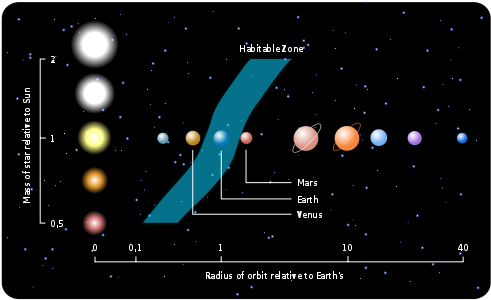
Image: Habitable zone relative to size of star. Credit: Wikimedia Commons.
Much could be said about biosignatures themselves. On the Earth, oxygen, ozone, methane and carbon dioxide are produced biologically, but could also occur naturally in the atmosphere of a planet that was devoid of life. So it’s not so much a single gas but a combination that tells the tale. A biosignature would be the simultaneous presence of these gases in quantities telling us that life must be part of what is keeping them in production. On that score, Seager’s last term — the fraction of planets on which life produces a detectable signature gas — is cunning because it leads to the basic issues that will have to be resolved as we broaden the hunt for life. Says Seager:
I carefully crafted the last term of this equation so one could actually add more information in. Does life produce a detectable signature? Are there systematic effects that rule out some biosignature gases being detected in some planets? Can we not find the signature for technical reasons? We just don’t know how many planets have life that is producing biosignature gases that are detectable by us.
None of this de-emphasizes the current SETI effort, which proceeds with Drake’s Equation very much in mind. But Seager’s new equation is a nice addition to the exoplanet toolkit. After all, we have no idea whether or when a SETI project will pull in evidence of an extraterrestrial civilization. But in Seager’s view, there is at least “a remote shot” that we’ll detect a biosignature within the next ten years. Inferring some kind of life on a distant world isn’t like being handed the password to the Encyclopedia Galactica, but it would tell us that life is not confined to our own world.
How striking to think that the first discovery of life elsewhere may come from the light of a distant exoplanet rather than from an object in our own Solar System! But ponder: Seager is talking about a possible biosignature detection within a mere ten years. Are we likely to have unambiguous evidence of life on Mars, Europa or any other nearby object as soon as that?

Exomoons: A Fine Line for Habitability?
Public interest in habitable moons around gas giant planets received a powerful boost from the film Avatar, where a huge world in an Earth-like orbit (Polyphemus) is accompanied by the extraordinary moon Pandora. We have no detections of such moons — exomoons — but as we’ve seen in earlier posts here, David Kipping (Harvard-Smithsonian Center for Astrophysics) continues the hunt through the HEK project (Hunt for Exomoons with Kepler). HEK looks for transit timing variations (TTV) and transit duration variations (TDV), the kind of perturbations that a substantial satellite would create in the orbital motion of the larger world around its star.
While we wait for the first exomoon discovery — a moon down to about 0.2 Earth masses should be detectable with these methods — we’ve just gotten a look at exomoon issues from a new study of magnetic fields around giant planets. The work of René Heller (McMaster University) and Jorge Zuluaga (University of Antioquia, Colombia) finds that merely being in the habitable zone is hardly sufficient protection for any lifeforms that might develop on such moons. Not only are there issues relating to tidal heating and the transport of energy in the moon’s atmosphere, but the magnetic environment in which these moons would move could be a show-stopper.
Heller and Zuluaga’s new paper calculates the size of the magnetospheres of giant planets located in the habitable zone of their host stars. Being inside a planet’s magnetosphere can shield a moon’s surface from high-energy cosmic rays and the effects of the stellar wind from its star, but particles trapped in the magnetosphere itself can create their own problems. The paper notes that the net e?ect on a moon’s habitability depends on its actual orbit, the extent of the planet’s magnetosphere, and other factors like the intensity of the stellar wind from the star.
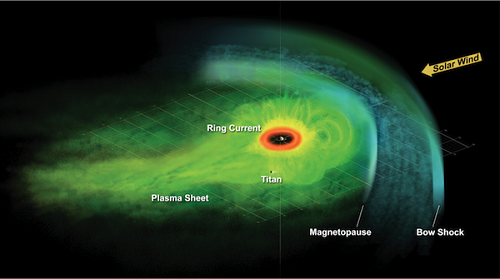
Image: An artist’s concept of the Saturnian plasma sheet based on data from Cassini’s magnetospheric imaging instrument. Credit: NASA/JPL.
The researchers have pooled information about the formation and development of magnetic fields in both terrestrial and giant planets and use it to predict the intensity of those fields, based on models developed by Jonathan Fortney and his collaborators at the University of California. They chose to exclude planets around M dwarf stars because of flare activity and excluded G-class stars as being too bright and too massive to allow for exomoon detections in the near future. The compromise was to work with K-class dwarf stars of about 0.7 solar masses.
The work then considers Neptune-, Saturn- and Jupiter-class host planets. As to what may be detected in the ongoing exomoon hunt, the paper argues that moons roughly the mass and size of Mars are likely to exist and should prove detectable around K stars in the near future.
Having determined the scope of a magnetosphere, the other factor that comes into play is the distance of the exomoon from its host planet. Working with Rory Barnes (University of Washington), Heller has previously studied the minimum distance a moon could orbit while sustaining habitability despite the effects of tidal heating (see Assessing Exomoon Habitability for more on this recent work). Get too close to the planet — Barnes and Heller called this moving inside the ‘habitable edge’ — and runaway greenhouse effects can emerge. There is, in other words, a minimum distance an exomoon has to maintain from its planet to remain habitable.
But does the minimum distance conflict with the magnetosphere?
From the paper:
For modest eccentricities, we ?nd that satellites around Neptune-sized planets in the center of the HZ around K dwarf stars will either be in an RG [runaway greenhouse] state and not be habitable, or they will be in wide orbits where they will not be a?ected by the planetary magnetosphere. Saturn-like planets have stronger ?elds, and Jupiter-like planets could coat close-in habitable moons soon after formation. Moons at distances between about 5 and 20 planetary radii from a giant planet can be habitable from an illumination and tidal heating point of view, but still the planetary magnetosphere would critically in?uence their habitability.
Perhaps the odds on finding a Pandora out there, around a Jupiter- or Saturn-class world, are not as good as we might hope. If far enough from its host planet to avoid runaway greenhouse issues and the disrupting effects of tidal heating, the exomoon could outrun the magnetic shielding of the parent world, exposing it to stellar and cosmic high-energy radiation. But Heller and Zuluaga acknowledge that the planet’s composition has much to say about conditions on any moon. The paper goes on to point to the direction of their future work on the subject:
Once a potentially habitable exomoon would be discovered, detailed interior models for the satellite’s behavior under tidal stresses would need to be explored. In a forthcoming study, we will examine the evolution of planetary dipole ?elds, and we will apply our methods to planets and candidates from the Kepler sample. Obviously, a range of giant planets resides in their stellar HZs, and these planets need to be prioritized for follow-up search on the potential of their moons to be habitable.
The paper is Heller and Zuluaga, “Magnetic shielding of exomoons beyond the circumplanetary habitable edge,” accepted at the Astrophysical Journal (preprint).

Musings on Starship Congress 2013
Centauri Dreams readers will be familiar with Kelvin Long as a contributor here and as the author of Deep Space Propulsion: A Roadmap to Interstellar Flight (Springer, 2012). But the indefatigable Long has a broad range: He is the co-founder and Executive Director of the Institute for Interstellar Studies, former Vice President and co-founder of Icarus Interstellar, Managing Director Stellar Engines Ltd and Chief Editor of the Journal of the British Interplanetary Society. Fired with enthusiasm after the recent conference in Dallas, Kelvin took a new tack in this piece, wanting to communicate the experience of immersion in the new interstellar movement.
by Kelvin F. Long
 We huddled in this place, gathering our kindled fires and showing them to each other “look what I made”, “look what I discovered”, each with a gleam and a tear in the eye as we thought of the visions of vessels that could travel across space to other places and other times. This was the gathering from across the planet Clarke called Ocean, although the inhabitants of its lands knew it as Earth. They travelled and arrived, with expectations and excitement brimming to the boil as the presentations rolled out one by one, over a packed and eventful four days.
We huddled in this place, gathering our kindled fires and showing them to each other “look what I made”, “look what I discovered”, each with a gleam and a tear in the eye as we thought of the visions of vessels that could travel across space to other places and other times. This was the gathering from across the planet Clarke called Ocean, although the inhabitants of its lands knew it as Earth. They travelled and arrived, with expectations and excitement brimming to the boil as the presentations rolled out one by one, over a packed and eventful four days.
Boy and girl, young and old, we spanned over a century in the history of the human timeline, sharing our experiences, knowledge and wisdom, laughing and crying at the truths revealing themselves to us as the whispers and the breath left our lips and entered the ears and minds of each other. We talked about technology and engines of all types; riding the light of beams, or sailing on an electromagnetic wind from the Sun, or energising the atoms of hydrogen, to release those little photons of energy. Those timeless particles, which contain the very tease that they can travel at speeds we can only dream of. One of our own called Albert, out of a place called Bern, forbids us joining their frolics and we must forever stay bounded to the speeds of particles of matter. But others have alternative ideas, to reverse the charge of matter itself, and in a laboratory to see the cosmic curvature warped.
We gnashed our chins about space probes, big and small; the size of Moons to the size of pins, there was no limit to the meaning of a Starship in our minds eye. They all had structure, payloads and engines of some sort and everyone had their favourites, defending them like kids harking on about their favourite sport cards in a sticker book. The forces of nature were used in their fury, all to be bent, twisted and perturbed by the power of our mentality. Magnetic and electric fields to move excited charges, nuclear forces to harness energy for power, and gravitational forces to tame those dark stars of the deep, from which only a singularity grows and light is forever trapped within an eternal prison, from which mirages of relativity play out in the optics of our eyes. All obstacles to the goal were seen as that, obstacles to be climbed or loop-holed, there was nothing that could block our path to the pin pricks of light in the night. Our ambition knows no boundaries, and indeed we are Kings and Queens of infinite space, and we are not bounded by any nutshell.
The very definition of technology was debated and placed in the context of a living architecture, and not just in the perspective of inert constructions devoid of process in themselves. Our convergence with it was seen to continue ever more, as we rushed towards the future together, towards a dualistic landscape where the separation between us, and them, become blurred and even meaningless. In such a future of possibilities, how can we think to extrapolate as to what and when might occur? How can we conceivably fathom what is at the end of the road, when we are yet to even set forth on the journey?
The existence of “them” was thought through, and our possible encounter should it ever come to be. Some would have us shout now into the darkness “we are here come find us” whilst others would have us be silent and utter a hushed discrete tone. Are they waiting for us? Is there no-one? Let’s go see we said, let’s build vessels made of matter and energy to cross space and time and have these aged old curiosities slain to the books of our encyclopaedias. And what might we learn? That we are very small and really nothing of significance, or that we are similar to them, struggling to survive and prosper in the great Universe of age, as the Starmaker moves on dispassionately, perhaps to create another one of its other experiments and to begin the cycle yet again.
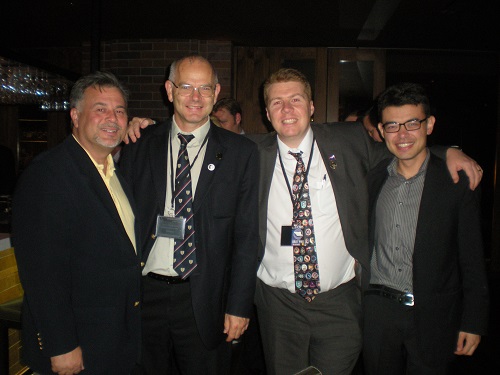
Image: George Abbey Jr., Rob Swinney, Kelvin Long and Andreas Hein at Starship Congress. Abbey and Swinney are deputy directors for the Institute for Interstellar Studies. Hein is director of I4IS technical programs.
And for the first time, many came together, not for themselves, but on behalf of others, in a congressional session. Questions were posed, designed to tease out views, to create conditions of discomfort so that reasoned debate may be afforded, to fully scope that space. All people were civilized, courteous and wise, no fighting over electronic devices so that the world could hear just them, but all were to be heard, so was the consensus. We are one people, from this planet called Ocean that contains a little dirt; yet, we fight over that dirt, and seek to own one spot so that another cannot have it. But the grand adventure of the stars forces us to see beyond that measure, to see ourselves in a different context, not as a divided people, but as one with a common ancestry and in harmony with each other. Our trajectory is co-joined, the stars call us loudly across the void of the deep, and we answer in no uncertain terms; “We… are coming”.
The Starship builders – we are the dreamers of the future and the children of the renaissance Master. We see no boundaries to our desires and we are strong and steadfast in our vision to see it achieved. There is no holding us back, we are an ever present tide, an ever arriving force, and though we may drift from time to time from our path, we will always long to return to our goal and see it continued, because that is the compass of our migration, to return from whence we came.
I’m asked for my recollections of Starship Congress 2013 and I could tell stories of what was said and who did what. But it’s better to convey the emotion of the event, to place it in the context of its humanity, that we were there, and we…were moved. Oh what hope we can hold for our species when we do things like this, what optimism, what power we have over ourselves. Let’s have more of it, let’s talk, lets travel, lets design, lets calculate, let’s build…let’s be one people facing the challenge of the stars and see it solved in this generation or the next. Our equations play music to us, as they sing the song of the Starship, and we each try to compose a melody that resonates to the challenge, and thereby claim “Eureka! I have got it”. But no, we have all got it within ourselves and this then is our task – to put fires in the bellies of all the people of the world, to liberate them from their monotonous existence and shout “WAKE UP!….DON’T YOU KNOW THE STARS ARE CALLING YOU TOO?”

